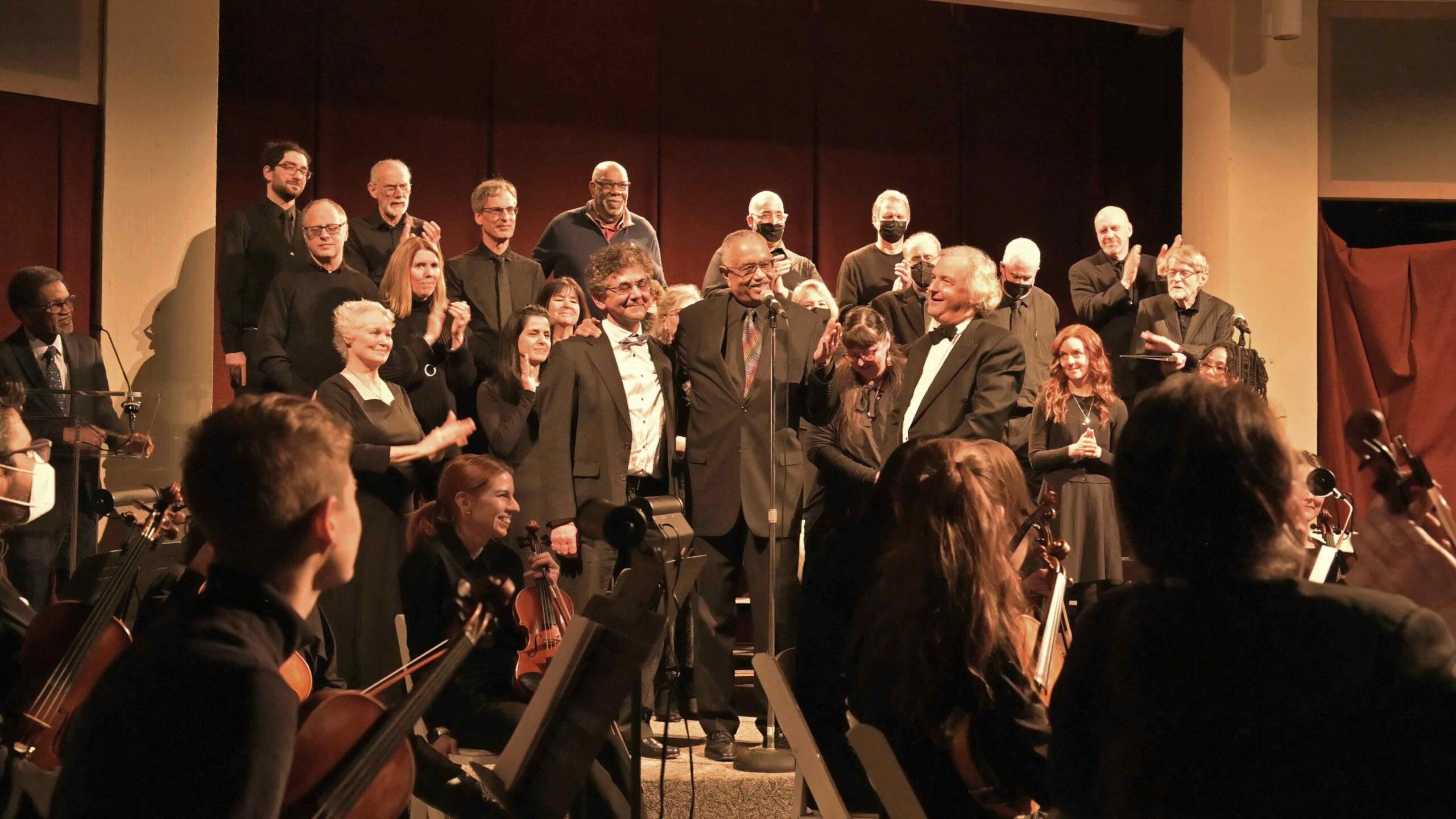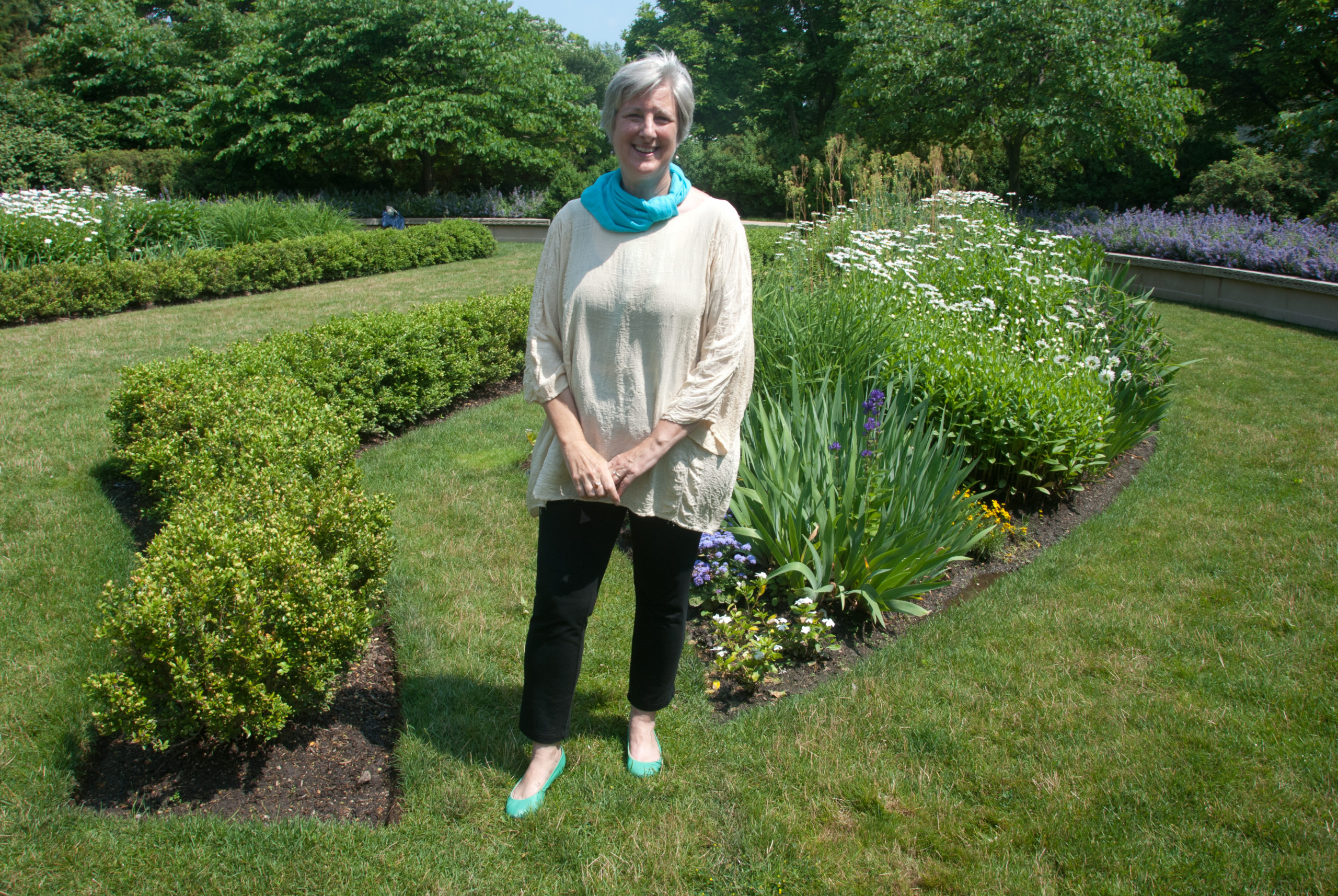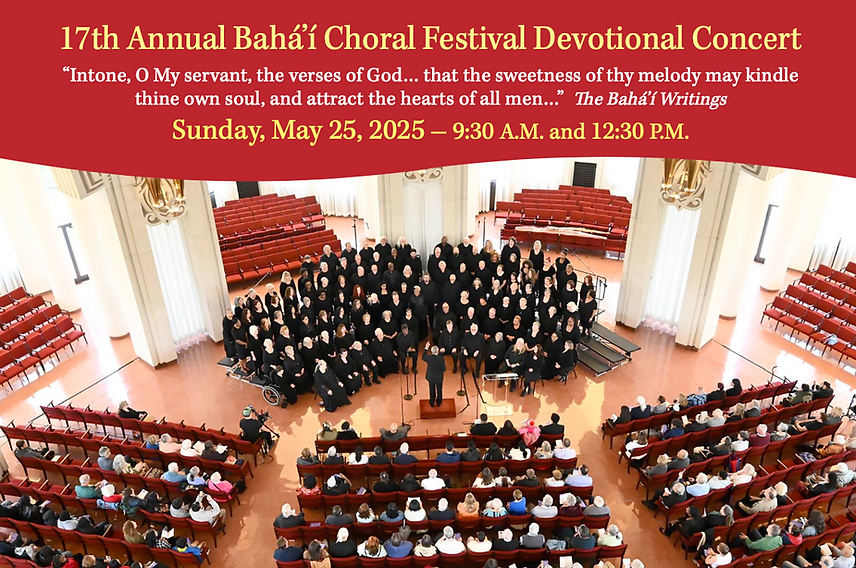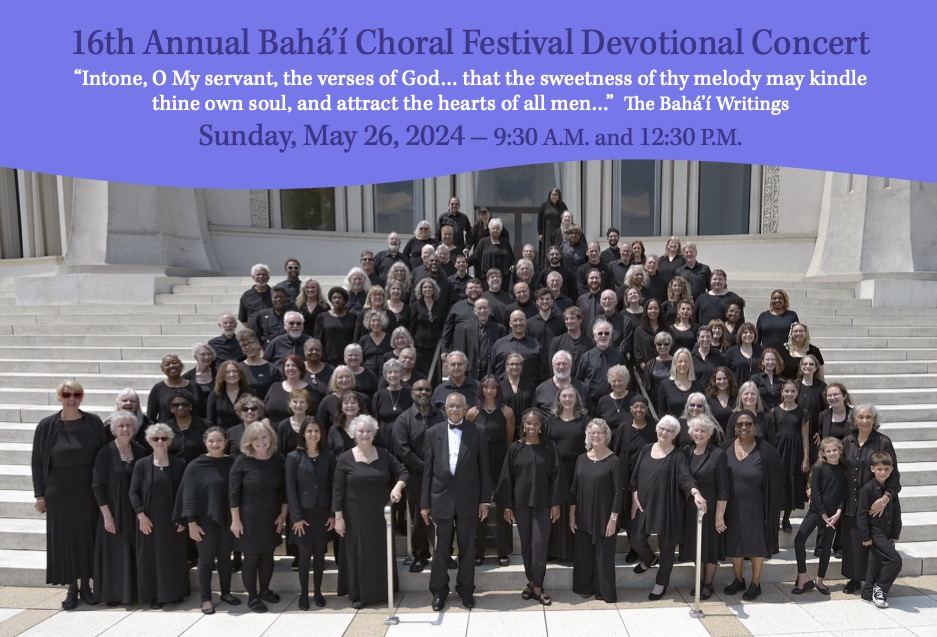
A Garden Walk through Sacred Space

The gardens that surround the Baha’i House of Worship in Wilmette, Illinois, are extensions of the sacred space of the Temple. Come for a walk with Landscape Architect Carol Yetken as she guides us through some of the behind-the-scenes efforts in creating these lovely gardens.
Interview Transcript
[00:00:00] Joyce Litoff: The gardens that surround the Bahá’í House of Worship are extensions of the sacred space of the Temple. This is Joyce Litoff with the U.S. Bahá’í News. Today, we visit with landscape architect, Carol Yetkin. In the background, you will hear teams busy, mowing, trimming, and planting, all to make these gardens the soul soothing, fragrant, and peaceful places that they are.
Come for a walk with us.
[00:00:28] Carol Yetken: First of all, one of the most important aspects of the philosophy of our design is that the original design was done in concert with the design of the building. And it did follow the completion of the building because Shoghi Effendi said that basically, no, you can’t open the building unless the gardens are finished.
So it took them an extra couple of years. And then in 1953, the gardens and the building were opened. One of the most lovely aspects of the gardens is that they really are a compliment to the building to extend the space of peacefulness and meditation in nature. And of course that’s something that really resonates with me.
I probably like architecture more than the average person. And Chicago is also an extremely architectural community. So people are always interested in that. But the fact that we have this interlocking of this natural environment with the architecture is really spectacular. I mean, if I want to find a place of peace, the gardens are the kind of place that I would want to come to.
It really expands the purpose of the House of Worship being here. As a place for all to come to and a place of peace. So the gardens are this kind of soft compliment to the architecture of the temple. We also then have the nine gardens and the circle walk, the circumambulation walk, which is really the purpose of it is the element that ties it all together.
So we have the insides of the gardens that we’re looking at and each of the gardens have a number. This is where typically we do more floriferous kind of things then we do annual displays in the middle. A number of the gardens have perennials and shrubs and things that are particularly colorful all summer long.
Then on the outsides, we have these ensemble of plans. Each garden has these four set piece trees, and then they are planted more or less the same on each side. And each of the nine gardens has a completely different set of plant materials. So we have spring bloom. We have, um, the plants are doing something in the summertime.
Sometimes they’re fruiting. We have fall color. And then even in winter, there’s this wonderful evergreen frame that completes the garden. I love to see the gardens actually tucked in for the winter because you can really see the formality of the design. It has its own kind of peacefulness when they’re tucked away.
[00:03:16] Joyce Litoff: So this four seasons forethought, is that typical of someone who’s doing landscaping or is that something special to this application?
[00:03:27] Carol Yetken: It’s a little of both. This garden was designed in the 1950s and. I have to admit that evergreens were extremely popular in that post-World War 2 era. So our garden does have a very, very solid backbone of these evergreens. But yes, I mean, I think we had the benefit of a mature design professional. The gardens were designed by Hilbert Dahl, who was a Baha’i, but he was also in kind of the Eve of his career. So he was a very experienced landscape architect and engineer. He writes that the garden should have sympathetic (natures?) My interpretation of sympathetic goes back to kind of the philosophy of the Baha’i Faith of having respect for nature to create a more sustainable kind of environment in order to do that.
You may remember 25, 30 years ago, absolutely everything in this garden was being sheared. Sheared into these little boxes. This hedge was about maybe waist high and it was being sheared into this little box.. Three times a year, four times a year, all of these shrubs were being shared into these little ball shapes.
Nobody realized that they bloomed. And so we lost an incredible dimension to the garden. We were sort of forcing the plants into an artificial shape, but we were also really losing a lot of the qualities that the plants themselves are giving to the ensembles.
[00:05:03] Joyce Litoff: And because that’s just what was done.
[00:05:05] Carol Yetken: It’s just what was done.
It’s still done. You will see for all of July, you’ll see the landscape contractors out there with their shearing tools, shearing everything off into these Gumdrops, or these irregular shapes. One of the first things I did when I came is I stopped the practice of shearing and everything here is now hand pruned.
So the ensembles that Hilbert Dahl started had a lot of those qualities that were just being cut off. As time has gone on, we have had to change plants out in the ensembles that we have tried to keep the spirit of the character and the design of the gardens as much as possible.
[00:05:46] Joyce Litoff: So what percentage of what’s on the ground is actually original to the planting?
[00:05:51] Carol Yetken: Very good question. Actually, not very much anymore. Almost all of the ninebark hedge is original. It is either left and was kind of out of the way of the construction enough, or we actually propagated a lot of it when we had to take some out, we saved some over in a nursery and we’re able to reuse it. So I would say probably as much as 80% of the hedge is original, many of the evergreens here on these approaches, even though they were in very, very dire condition 20 years ago, when we started a new pruning regimen. They were in very poor condition. I would say about half of these are actually original, we were able to rejuvenate them through a hand pruning regimen. Most of the trees that are actually around the perimeter are original. And I think we only have one set of the set of four trees left that are original and they are the hawthorns that are around in garden nine.
So that brings us to the restoration of the gardens. In addition to changing the pruning regimen, we did make some decisions to change things. Each of the gardens has a different pattern, but they’re all framed by this evergreen frame. And again, that sort of sets that winter summer relationship. These had been used but they had gotten gigantic. And so they completely outscaled and actually covered up the flowers that were in the display area. So we did make the decision to change to boxwood, which wasn’t such an available plant in the 1950s. So we did make the decision to switch out that particular plant because it grows very slowly to keep it in scale with the garden.
[00:07:43] Joyce Litoff: I’m a novice. So I’m just asking sort of the logistics of how you plan this out.
[00:07:49] Carol Yetken: We went to a wonderful process. First of all, thanks to the lovely Baha’i Archives, we have all of Dahl’s original drawings and plant lists. So that was kind of our first critical baseline research that we tried to figure out what the ensembles were that Hilbert Dahl originally designed, and what was the character of the plants? For example, in one of the gardens, he used a plant called Mahonia. Well, Mahonia pretty borderline for here and very, very hard to find, but we looked at the characteristics of the Mahonia it’s called a Bradley evergreen. It looks kind of like Holly. Where he had put the Mahonia in we used a plant that had some similar characteristics, and that was Holly.
Unfortunately, the Holly wasn’t successful either. Either due to localized climates. Every one of these gardens and approaches has its own little set of microclimate issues.
[00:08:47] Joyce Litoff: Oh, that’s really interesting.
[00:08:48] Carol Yetken: Yeah. And especially because we’re on the lake, it’s even more exaggerated. We have wind that comes off the lake. We have wind that comes out in the Northwest. Wind that comes out of the Southwest. And when it swirls around the building, we get all of these odd micro-climates not to mention the fact that we get a lot more moisture from the lake. It’s often cooler here, five to 10 degrees cooler than any place else.
Um, sometimes there’s fog in the morning. So there’s a lot of dampness that stays around and that all plays into the culture of the plants. Hilbert Dahl’s original plan was really our guide. And then we tried to choose as wisely as possible to create these ensembles and for each garden, each garden has a different set of plant materials.
[00:09:34] Joyce Litoff: I know that each of the gardens is planted differently, but are there any direct symbology from what’s planted?
[00:09:42] Carol Yetken: Something like the rose garden, for example, the rose is, I think particularly resonant with people, of Persian background and sort of Middle Eastern background. So we have kept the rose garden and we actually have roses in another garden as well.
Just because there is that connection and there’s so many references to roses in the writings and for the gardens that we do in the annuals, we change those out twice a year in the spring, and then in the summer. And many of those annuals have origins from all over the world. Madagascar Vinca, Um, the osteospermum that are in the, in the beds at the Welcome Center, I think have African origin, for example.
So it is just a characteristic of our plant palette that we do approach this with more of a Botanic interest. Than necessarily saying everything has to be native, for example. So we do have plants that are representative of things that grow from all over the world. Obviously we try to find things that are going to be culturally successful.
[00:10:49] Joyce Litoff: I can already smell these wonderful roses. Do you select the variety for the fragrance, for the appearance, some of each.
[00:10:57] Carol Yetken: Some of each. These are David Austin roses. These were not the original selection that Hilbert Dahl started with. As you may know, rose culture has a very long history of hybridizing and breeding and all of that.
These are all a breed called David Austin roses, which are pretty robust and have much less disease problems. They’re also very floriferous. They, they produce a lot of balloons and some of them are also fragrant, not all of them, but many of them are also fragrant.
[00:11:29] Joyce Litoff: You have enough of them here that I’m getting the fragrance.
[00:11:32] Carol Yetken: So these have proven to be much more solid performers for us. You know, we still have a special regimen just for the rose garden. We do have some Japanese beetle problems, although not as dramatic as it was before we started more lifecycle treatment of the Japanese beetles, which means you need to treat for grubs.
The Japanese beetle actually come from the grubs that are in the lawn. So once we started nipping that life cycle. It has helped a lot in terms of the, of the treatment.
[00:12:04] Joyce Litoff: What I think is fascinating is a landscaper might have one particular issue in a place, but you’ve got all of these issues in all of these places.
[00:12:14] Carol Yetken: Each garden has kind of a similar arrangement with completely different plant materials. So here we are on the right side, we have a south facing garden, which gets nice, lovely sun all the time. On the other side, on the south side, we actually had a hedge here. And so it’s extremely shady. The plants are not doing nearly as well, so we constantly have this problem and we can see how far behind the hydrangeas are from one side to the other. Well, yeah, so we constantly have these issues of trying to select plant materials that will do well in sunnier conditions, will also do okay in shadier conditions, so that we can keep some balance. And then we’ve got the microclimate thing. We always have a wind in garden aid.
There’s something about coming around the north side of the building, that there’s always a wind there. And so that has played havoc with the plant materials that like those kinds of conditions. What about irrigation? We do have irrigation. That was one of the benefits of redoing the gardens is we did a complete irrigation system for not only the lawns, but also all of the shrub entry areas.
I think there are as many as 12 or 16 zones in each garden segment in a year like this year, it’s easy. We’ve had plenty of rain and we only have to do some spot watering, annuals need pretty regular water, which is why we’re using them in more and more limited ways. But if you have them, you need to take care of them.
So they thrive and they look beautiful. So we’ll have to make a correction for that. They’ll have to put that zone on more frequently, or they might even need to hand water, which is the least sustainable way to use irrigation, but it’s sometimes effective for spot application.
[00:14:03] Joyce Litoff: There are a lot of people who come in the spring just to see the tulips. And they always ask how many tulip bulbs are planted.
[00:14:09] Carol Yetken: We have actually made a decision to greatly curtail that effort.
[00:14:15] Joyce Litoff: You had something like Jonquils to me this year.
[00:14:18] Carol Yetken: Yeah. We had Jonquils and these are for a couple of reasons. At one point the number of bulbs that were planted and they were planted everywhere.
So much that it was too much and it overshadowed everything about the structure of the gardens, the ensemble of the plant materials. And it started to become its own thing,
[00:14:41] Joyce Litoff: Which is why I asked the question that people come just for the tulips.
[00:14:44] Carol Yetken: We started quite awhile ago, 15 years about really reducing the amount of tulip.
And the other thing is the deer love the tulips. And so we were in this constant battle, spraying them with deer repellent, kind of vile smelling stuff for the first couple of hours that it sprayed on. And they’d love to just eat off the tops of the tulips. Yes. And they leave the rest of the stems there and they just look really bad.
And so we, we are taking a more holistic and more sustainable view of the gardens. And so we did switch over to the Jonquils, to the Narcissus
[00:15:20] Joyce Litoff: To make the crowds happy! [laughter]
[00:15:23] Carol Yetken: After a long winter, especially after the last couple of winters we’ve had, it’s like, oh my God. So much snow, so much cold, so much ice. It’s so refreshing to see something start to move on its own, and spring and be colorful.
So the spring bulbs, I think, are an important part of our palette, psychologically.
[00:15:41] Joyce Litoff: Yes, yes…
[00:15:42] Carol Yetken: We did switch out to those which the deer don’t like. So we still get the benefit of that spring color and that’s growth to see happening on it all on its own, but without the downside of having to really spray them and try to keep the deer chase down.
[00:15:57] Joyce Litoff: Oh, I’m so glad I asked about that. I must say that this is such a relief just to see this expanse. It’s restful.
[00:16:03] Carol Yetken: And that is the whole rationale. The approaches are just very calm and very green. And the insights of the garden are where all the color starts. Over the years, we have reduced the amount of places that we had, the really bright, colorful annuals, and have focused them more on the interiors of the gardens and the display beds, which was the original intention of the design.
So underneath this expensive line is actually a huge cistern. Um, I think it’s about 40,000 gallons. And the water is collected actually on the building and then it is routed and it’ll come through the cistern and then we’ll use this water first for our irrigation system. The conundrum of a cistern is that usually in a year like this, you have an abundance of rain.
We don’t need to run the irrigation system very much. We shouldn’t have to use city water at all. It will be a great savings to the cost of operations. But in addition to that, you’ve got real rainwater that you’re using and it’s also air temperature water. It’s not cold water. So it has again, a double benefit of capturing enough water and being able to use it to create a healthier environment.
So this is a garden that has gone a little bit awry. We did try, you can see the purple groupings here. Um, the Lupines are a perennial, the purple flowers that are sort of spiking here. They’re a flower that I particularly love. They’re very, very hard to. And the idea was that we would introduce a perennial into this garden.
And then we would supplement with annuals around it. This side was a little bit more successful to have more plants that survived the winter. On that side, we had almost none that survived. So, um, so we ended up with a little bit of unevenness in this particular display bed,
[00:17:59] Joyce Litoff: So this is like the seed pod?
[00:18:01] Carol Yetken: That’s a seed pod. That seed pod will ripen. And last summer, they continued to bloom because it was so cool last summer, they continued to bloom all summer. This is a variety of plant that is actually native to the dune areas around, around the Southern end of the lake. They normally bloom in the spring and they’re very dramatic.
So the idea was that these would be planted kind of in the interior of this bed. And they would come back from year to year, and then we supplement that with annuals.
[00:18:31] Joyce Litoff: How long have you been involved in the landscaping here?
[00:18:34] Carol Yetken: We were called in first, about 20 years ago when the concept of doing the restoration efforts on the temple and the gardens was kind of broached.
So we spent the first couple of years. Just, we did an inventory of everything that was here. We compared it against Dahl’s original drawing, so we could figure out what had departed from the original plant materials and the original design concept. Frankly, looking twenty-five years ago, we were pretty far away from the original design concept.
And one of the first things we did is we started to remove plants that were completely inappropriate. Like we would have Hosta out in full sun and it would look very parched and very out of place all summer long. We did some of this gradually over several seasons. So we started clearing the plants that were inappropriately placed.
And I think what had happened is that when something would die or fail as it does all the time in gardens, there was no one guiding the big picture of what was being done. So, if something died, the gardeners go to the local nursery, they would just buy something and they would stick it in whether or not it was part of that original design concept or suited to that particular cultural requirement or not.
And so the gardens had really become a hodgepodge.
[00:20:02] Joyce Litoff: Oh, there’s a rabbit right there.
[00:20:04] Carol Yetken: Yeah. We had a lot less from rabbit damage. A plant will survive one cut back by rabbits. Maybe two, but usually after the second one, they’re pretty finished. The big things with the spiky blooms on them that you see there. Those are Bottlebrush Buckeye, and it’s like the Buckeye Tree, but it’s a shrub form.
And those have actually been introduced to the gardens by a horticulturalist after the original gardens had been planted. So they’re not original. But they’re really spectacular. And for them to be this large, you know, they’re old. Then we actually removed them. We took them over to the lake lot, managed to keep them alive. And then we brought them back.
So we have moved maybe 20% of the plant materials that you see are things that we salvaged from the original gardens. And then we brought them back.
[00:20:55] Joyce Litoff: So it would probably vary season to season, but how much time do you physically spend here on the grounds?
[00:21:01] Carol Yetken: So behind the scenes, we plan all of the display gardens and all of the new installations and also our remedial work.
And then two other areas. We come up weekly for an inspection and we meet with the gardeners and we have our little shortlist of things that they should be paying attention to. We have an overall calendar, of course. That deals with stuff like spring cleanup and cultivation and composting and mulching and all of that, pruning.
Pruning’s huge here. They spend most of July and August actually pruning and nipping and tucking. So that’s a pretty big activity here. We come up weekly. And, um, so we’re always engaged in that process.
[00:21:45] Joyce Litoff: Well, is there anything else? This has been so perfect.
[00:21:49] Carol Yetken: The only other thing I didn’t mention, I think is not only we’re trying to work with the nature and the characteristics of the plant materials, but we’re also always looking at how the plant collections live with each other, but it’s also kind of a unity in diversity issue. These trees in each garden should be the big statements along the outside. The hedges are sort of the neutral, calm divider as the background to these collections of plant materials that are along the edges.
Also keeping these plants in scale, so that they’re the right height in relation to the trees. And it’s all kind of a molding. We went to work with the character and we’re not just going to splash the plants because they’re not quite right or something. It’s all this, everything learning to live with each other. It’s really part of the philosophy of letting each of the plants have its time of glory and its own character.
And yet it all has to learn to live with everything around it. So keeping the scale of the plant materials in relation to one another is a very important part of the gardens, but it’s also directly from a divine concept. A divine principle.
[00:23:00] Joyce Litoff: Therein is the lesson for humanity.
[00:23:02] Carol Yetken: Yes. In fact, yes.




